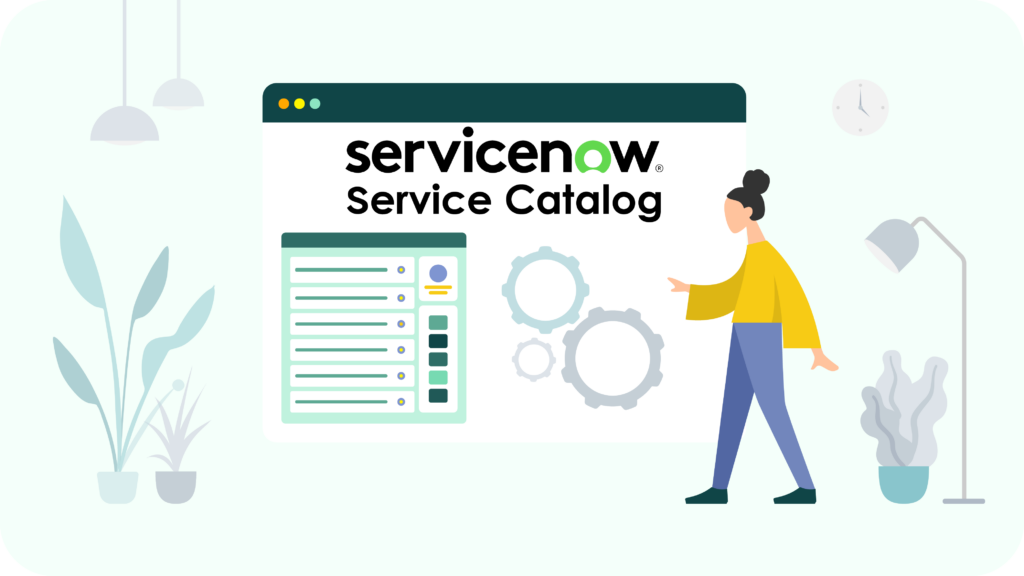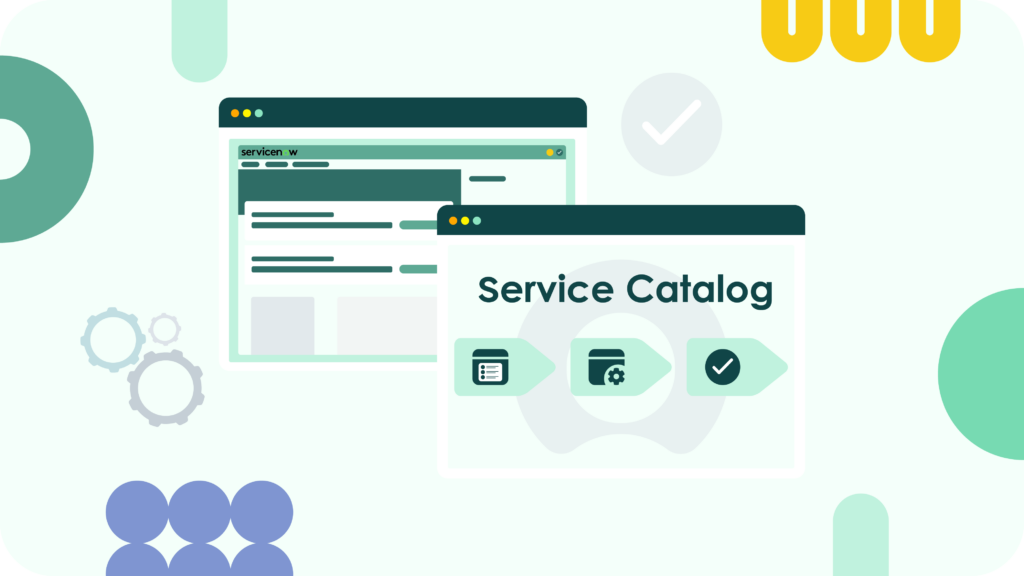ServiceNow Service Catalog is a key requirement for organizations’ management improvement. Connecting customers to services via well-defined and optimized service catalog IT is a must for any evolving organization as it gives users an understanding of how IT organizations can help them do their jobs better. It also enables organizations to manage and deliver services and products faster and more effectively.
This article will give you a complete understanding of the ServiceNow service catalog, structure, and benefits. We will look at ServiceNow catalog examples, items, and best practices to contribute to a seamless customer experience. Moreover, we will provide step-by-step instructions on its implementation to ensure fruitful use.
- What is Service Catalog in ServiceNow
- IT Service Catalog Benefits
- ServiceNow Service Catalog Examples
- ServiceNow Service Catalog Items
- ServiceNow Service Catalog Best Practices
- Tips on How to Create Service Catalog in ServiceNow
- Recap

What is Service Catalog in ServiceNow
A service catalog overviews a company’s IT operations and helps you manage the resources available to deliver services more quickly and efficiently. If done right, its implementation will help improve the quality of IT service delivery to meet business needs and objectives at the lowest possible cost. Understanding service supply costs gives us confidence in making important investment decisions.
What is Service Catalog in ServiceNow? It’s a tool that formalizes and structures the activities of the IT department. It is a centralized easy-to-use request portal that gives access to different business services and users can browse it even on mobile, making it possible to view all the products and services and approve all the requests on the move. Moreover, users can quickly get services using the Virtual Agent and create products and services ascertainable through self-service.
Service Catalog vs Service Portfolio
When the company starts defining its ITSM strategy, it can opt for two different services: service catalog and service portfolio. What is the difference between them?
The main distinction is the kind of services they offer. While the Service Catalog shows a list of products and services currently available for its users, the Service Portfolio shows all the services (past, present, and future). The service catalog is easily accessible and lets users select items they need and submit requests for them in the blink of an eye. The system also shows the updates for requests and the progress of its processing. Service Portfolio is a kind of archive that includes the service catalog, the service pipeline, and the retired services catalog.
Choosing one can be difficult as both have excellent characteristics for IT organizations. Nonetheless, a service catalog is a must, as users should be able to access and choose the organization’s current IT services and products. Once you have it, you can also expand and include a service portfolio that will support past products, show the historical curve of the company’s activities, and track future products and projects.
IT Service Catalog Benefits

Service catalog IT is an essential bridge between the IT department and end users, ensuring effective and satisfactory service delivery. Let’s look at the most valuable Service Catalog benefits and discuss their impact on efficiency and user experience.
Enhance Self-Service
An effective IT service catalog gives workers easy access to the services they need to stay productive as it provides a complete database where they can look at the service directory as at the menu in the restaurant and choose software, hardware, and any other IT service they need to make their jobs easier. They can understand their needs and choose the most suitable product. Moreover, this simplifies communication with the IT team and streamlines processes and workflows when requesting IT services. The service catalog in ServiceNow can elevate IT service from basic to excellent and reduce the time and resources needed to resolve users’ issues.
Increase Operational Efficiency
An easy-to-use, all-inclusive service catalog IT is a must in today’s business world as it contains all IT services and highly relevant information about process execution and routing. Therefore, the service delivery can be sped up, and the costs of managing individual services cut down. It dramatically boosts overall IT and business efficiency.
Cost Minimization
The ServiceNow catalog provides automation that enables quicker processing of service requests, allowing IT staff to focus on more relevant business tasks. It also allows users to track requests themselves, consistently saving money and increasing user satisfaction. In the modern technological world where many employees work remotely, a service catalog cuts down the cost of running a support desk around the clock as it enables access to support resources anytime and anywhere where users can get more back, investing less time.
Standardization of Service Delivery
A clearly defined product catalog provides all the necessary information on exactly which services are offered, how they will be implemented, and how long they will take. It provides an easy way to find service solutions and submit IT requests. It ensures that the user and the IT staff know precisely all the steps to be taken to make the appropriate decisions and increase user satisfaction as all the resources are allocated ably and swiftly to resolve the issue.
Improved Productivity
Automating processes in the catalog in ServiceNow greatly improves its functionality and productivity as it allows companies to transfer requests quickly and without the manual intervention of IT specialists. Businesses can operate in a much more professional manner, reducing the costs of service, gaining users’ trust, and increasing productivity. As simple requests can be dealt with automatically, IT staff can perform strategic tasks in a prioritized and efficient manner and satisfy both users and employees.
ServiceNow Service Catalog Examples

There is no one-size-fits-all model for creating a service catalog, as it strongly depends on the needs and goals of each organization. However, most businesses use them to streamline service delivery. ServiceNow Catalog is a perfect solution, allowing users to build, maintain, and publish catalog items that pinpoint and resolve irregularities to ensure optimal performance. Search for a service or catalog item, perform workflow validation to identify potential problems, and define transitions between workflow actions.
Let’s look at some real-world ServiceNow Service Catalog examples in different fields where users can easily find needed catalog items and easily access them.
ServiceNow Service Catalog Items

While navigating the Catalog ServiceNow, you will find many categories full of Service Catalog Items that provide different services to the user as they are used to submit information, make a request, or create a task. Let’s have a look at some items in the service catalog.
- Standard catalog items can be ordered by themselves to gather information and publish a service to a user.
- Record Producers used to provide alternative ways of adding information, such as incidents, through the service catalog.
- Other guides allow grouping different catalog items into one single request.
- Content Items are used to catalog elements that give information.
Catalog items can be used to request a database or a package for new employees that includes software access or hardware setup, report a problem or a service interruption to the IT department, create a task item, or submit a proposal. Moreover, gathering information to make a record in a table is possible. Catalog items benefit businesses by providing an easy-to-use self-service tool for processing data, requests, and tasks.
ServiceNow Service Catalog Best Practices

To optimize the ServiceNow Product Catalog, let’s look at its best practices to ensure efficient use, please users, and help them understand how they can interact with the services.
Build the Right Management Strategy
Define the type of customers/users you want and the business objectives, examine current service offerings, dialogue with end users, create a simple and straightforward interface, and schedule the implementation of new functionalities.
Know Your End Users
This information will help shape the service catalog and the offerings. As the design is essential, understanding if it’s challenging to navigate helps to improve its functions and identify unused features to remove.
Offer New Services
Users’ feedback is critical and helps improve efficiency, resolve issues, accelerate processes, and reduce waiting time. Adding new accessible services can help users find what they want and reduce the workload.
Use Help for ServiceNow Specialists
The perfect catalog doesn’t exist, and to set up a functional one, use the help of professionals to build a plan and manage a portfolio that reflects the end user’s needs and makes it easier to provide IT services.
Communicate about Changes
Make sure users are notified about service changes to avoid confusion. The open and continuous line of communication will help test new features, and users will always know when the service is shut or retires.
Manage Service Catalog Confidently
Accessible communication will help to adapt the record to user needs and eliminate unused services. It also allows for a better understanding of the interaction between users and services and improves the catalog’s future goals.
Tips on How to Create Service Catalog in ServiceNow

Considering the need to implement a product catalog, ServiceNow and implementing it are very different. Here, we provide the main tips on creating service catalogs in ServiceNow.
Tip 1: Identify the goal and the objectives.
- Determine the business needs of the stakeholders.
- Specify service categories and make them congruent with the structure of the organization.
- Define SLA metrics like response time, resolution time, and availability.
- Designate Service Owners responsible for service delivery, maintenance, and improvement.
- Set up a management structure with policies, processes, and guidelines.
Tip 2: Define and document all the services
- Collect data from different organization services through surveys, checking documents, and contacting the departments.
- Classify services by purpose or function.
- Describe services, including their benefits, target group, and costs.
- Identify owners responsible for each service’s management.
- Determine service levels and metrics to meet business goals.
- Verify and validate all documented services after checking the stakeholders’ feedback.
Tip 3: Organizing services into categories
- Define categories, considering user needs, organization structure, and functionality.
- Provide small subcategories for easy navigation.
- Determine a category and subcategory for every service.
- Assign access rights based on user roles and responsibilities.
- Review and validate the organization to keep it up-to-date.
Tip 4: Design the Service Catalog Items
- Define a list of services for the directory.
- Identify users’ information needed to respond to a request and requirements to provide the required service.
- Write clear and brief descriptions of services like their purpose, costs, limitations, etc.
- Classify every item according to user role, type of request, or service.
- Specify price and SLA models for each element.
- Test and get feedback.
Tip 5: Set out Service Catalog Workflows
- Select services for the catalog.
- Outline workflows with all steps and requisites for each service.
- Annex tasks for every flow.
- Define conditions for the start and the approval of every task.
- Assign roles to approve tasks.
- Test and issue it.
Tip 6: Create Approval Services
- Choose criteria to configure the process.
- Make rules for every task.
- Check the process and all its elements.
To make sure that the service catalog reflects all the changes, it’s necessary to update it occasionally and keep track of improvements.
Recap
The pace of digital transformation is changing every second, and more and more organizations take into account the importance of end-user satisfaction while using IT services. Regardless of the sector, businesses worldwide depend on IT-enabled digital solutions for most aspects of their business that should be presented in an easy-to-access and well-organized way. Implementing a user-friendly and forward-looking service catalog is a key element in any organization’s race to achieve positive business results and receive maximum benefits.
Therefore, if the company is looking for a new option to streamline its IT service and meet the needs of both users and service providers, it should go for the ServiceNow Service Catalog, as it can significantly improve business operations and manage services effectively.
About acSoft Blog
For those navigating the complexities of the ServiceNow ecosystem, the acSoft blog serves as an indispensable compass, guiding enterprises toward unprecedented heights of efficiency and efficacy. Authored by a cadre of industry luminaries deeply vested in the ServiceNow community, our platform offers a sanctuary of knowledge, replete with meticulously researched insights and actionable counsel tailored to the discerning needs of modern enterprises.

